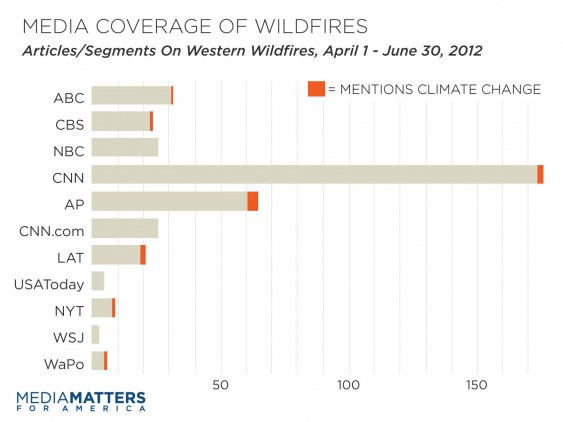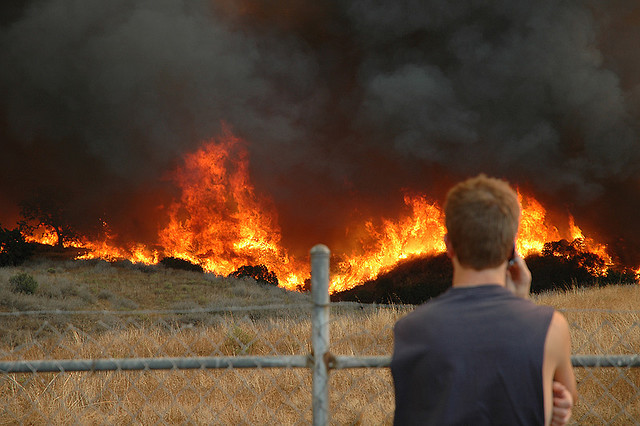The science is clear. Human-caused climate change is creating conditions where wildfires in many parts of the US are more likely to start, bigger, and harder to put out.
But, sadly, I’m veritably bowled over when a mainstream media outlet mentions climate change in their reporting on the wildfires currently devastating the West. (Just ask my husband how I’ve been yelling at the radio lately.) Of course, it’s refreshing when a paper like the Washington Post makes the wildfire-climate connections—even if I find a lot to hate about the three initial paragraphs of caveats and the scientist saying “I told you so” frame.
I’m probably not alone.
Media Matters for America, a nonprofit media watchdog, analyzed recent mainstream news coverage of wildfires and found that news outlets are avoiding the topic of climate change in wildfire stories.
Their analysis of coverage between April 1 and June 30, 2012, reveals that “mainstream media outlets are not up to the task”—only 3 percent of news reports on wildfires in the West mentioned climate change, including 1.6 percent of television segments and 6 percent of text articles.

Just Plain Bad Journalism?
Obviously, numerous factors determine the frequency, severity and cost of any given wildfire, but seven of nine fire experts contacted by Media Matters agreed journalists should explain the relationship between climate change and wildfires.
With the report, they published many quotes from the experts they contacted for the study, scientists and wildfire experts making the case that climate change is creating the conditions for wildfire danger and urging journalists to make the links more clearly.
Here are two that get right to the point:
In a Media Matters email exchange with Dr. Thomas W. Swetnam of the University of Arizona’s Laboratory of Tree-Ring Research, he summed up the news gap aptly: “Given the facts that year after year we are breaking century (or longer) records in wildfire area burned in the western US, and the warming trends are clear and as expected, the lack of any mention of anthropogenic climate change even with caveats is, in my view, irresponsible and bad journalism.”
Dr. Anthony Westerling of the Sierra Nevada Research Institute at the University of California, Merced, told Media Matters:
Yes, I think the media should connect the dots. Climate change has driven dramatic changes in wildfire in western US forests, and these and other changes will continue to accelerate with warming…Ultimately, however, the changes will be so significant, that the conclusion that climate change has been responsible for dramatic, negative impacts on our environment and quality of life will be inescapable. The public will want to know why they were not told of the consequences in advance. They will not blame themselves for ignoring the science, they will blame public institutions like the media and government.
Getting the Facts Right
Scientific evidence tells us that human-induced climate change increases fire risks in parts of the western US by promoting warmer and drier conditions. Along with quotes from experts, Media Matters’ short analysis is followed by a handful of links to scientific reports showing the wildfire connection to climate change. Here are a few:
- A recent study published in Ecosphere, the journal of the Ecological Society of America, found that the western US is particularly vulnerable to global warming’s impact on fires.
- The National Research Council reports that “for warming levels of 1°C to 2°C, the area burned by wildfire in parts of western North America is expected to increase by 2 to 4 times for each degree (°C) of global warming.” Particularly vulnerable areas “include the Pacific Northwest and forested regions of the Rockies and the Sierra.”
- A 2009 report commissioned by the Bush administration by the US Global Change Research Program said “Wildfires in the United States are already increasing due to warming. In the West, there has been a nearly fourfold increase in large wildfires in recent decades, with greater fire frequency, longer fire durations, and longer wildfire seasons. This increase is strongly associated with increased spring and summer temperatures and earlier spring snowmelt, which have caused drying of soils and vegetation.”
- A 2010 National Research Council report summarizing the state of climate science also stated: “[L]arge and long-duration forest fires have increased fourfold over the past 30 years in the American West; the length of the fire season has expanded by 2.5 months; and the size of wildfires has increased several-fold. Recent research indicates that earlier snowmelt, temperature changes, and drought associated with climate change are important contributors to this increase in forest fire.”
- A National Academies website notes that the warming trend has boosted the population of bark beetles that kill trees in western forests, creating fuel for fires.
And from the Washington Post:
- The 100-degree heat, drought, early snowpack melt and beetles waking from hibernation early to strip trees all combined to set the stage for the current unusual spread of wildfires in the West, said University of Montana ecosystems professor Steven Running, an expert on wildfires.
- As recently as March, a special report on extreme events and disasters by the Nobel Prize-winning Intergovernmental Panel on Climate Change warned of “unprecedented extreme weather and climate events.” Its lead author, Chris Field of the Carnegie Institution and Stanford University, said Monday, “It’s really dramatic how many of the patterns that we’ve talked about as the expression of the extremes are hitting the U.S. right now.”
And from Climate Communication:
- The exceptionally warm March in the US is but part of record warmth for the first five months of the year and, along with an absence of snow, the rapid snow melt has left the Rocky Mountains almost without snow by 1 June 2012. The very hot and dry conditions throughout the Southwest and Rocky Mountain Region have led to exceptionally high risk of wildfire. Multiple wildfires have already occurred, and several in Colorado and Utah have expanded into huge burn areas, resulting in loss of life and structures.
- As emissions of heat-trapping gases continue to rise, and global average temperatures continue to increase, we can expect even more of the extreme heat and related impacts we’ve been witnessing in recent years.
Clearly, journalists need not look too far for evidence (or experts to talk to for that matter) to produce better, more responsible news stories about what’s really going on.

